Hezekiah
was the king of Judah at a very critical period in the history of
the nation (716/15 -687/86 B.C.). The Assyrians destroyed Samaria
in 722 B.C. and then moved south into Judah. Sennacherib, in one
of his prisms, claims to have taken 46 Judean cities. The most famous
of these was Lachish. When Sennacherib returned to Nineveh, he had
the walls of his palace decorated with the siege of Lachish.
|
|
Entrance
to Gihon Spring. Solomon was anointed as king of Israel
at this spring (1 Kings 1:33, 38, 45). |
Hezekiah
served Assyria for a while and then rebelled (2 Kings 18:7). He
set about to strengthen the fortifications of Jerusalem (2 Chron
32:3-5). He had the fountains of water stopped so the king of Assyria
could not find water. He also built a pool and dug a tunnel. "Now
the rest of the acts of Hezekiah and all his might, and how he made
the pool and the conduit, and brought water into the city, are they
not written in the Book of the Chronicles of the Kings of Judah?"
(2 Kings 20:20).
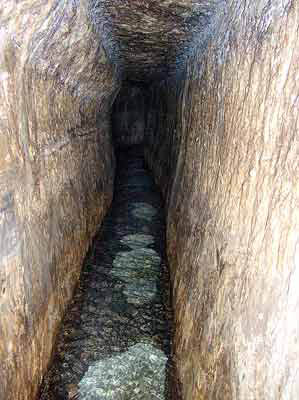 |
Inside
the tunnel. Unless one is claustrophobic, walking through
the tunnel is rather easy. The floor is much smoother now
than it was 10 or 20 years ago.
This
tunnel was cut about 710 B.C. by Hezekiah, king of Judah,
to bring water from Gihon spring to a new pool, later known
as the pool of Siloam.
|
The
water supply of ancient Jerusalem was the Gihon spring on the east
side of the city where Solomon acceded to the throne of David (1
Kings 1:28-53). About 1800 B.C., the Canaanites who lived in Jerusalem
built two towers at the Gihon spring, a Spring Tower and a Pool
Tower. Recent excavations have brought these to light and they can
now be visited. This is where the ancient inhabitants of Jerusalem
got their water. Hezekiah's tunnel brought water from Gihon spring
on the east side of the city to a newly constructed pool on the
west side. In New Testament times the pool was known as the pool
of Siloam (John 9).
The conduit or tunnel is a great engineering feat of antiquity.
Edward Robinson measured it at 1750 feet long. The tunnel was cleaned
and restored in 1909. The average height of the tunnel is slightly
less than 6 feet, with a width of 23 to 26 inches. There is a total
fall of 7 feet and 2 inches from the spring to the reservoir.
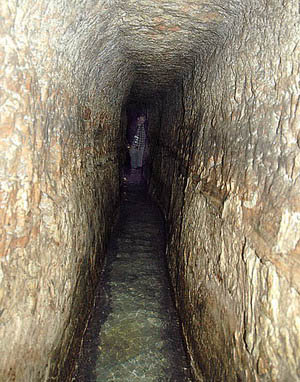 |
Still
inside the tunnel. My traveling companion, Leon Mauldin,
can be seen in the distance.
|
Digging
the tunnel has been estimated as a 6 or 7 month job. The Siloam
inscription was found in 1880 on the east wall about 20 feet inside
the Siloam end of the tunnel. The inscription is about two and one
half feet long, written in fine classical Hebrew. A. H. Sayce was
the first to decipher it. It reads in part: "…and the
waters began flowing from the source toward the reservoir for 1200
cubits…." The Turks controlled Palestine at the time of
the discovery so the inscription was taken to Istanbul where it
is now on display in the Museum of the Ancient Orient. Unfortunately,
it is in a section of the museum that is not always open to the
public, but I have been able to arrange several times for my groups
to see it. [The last two times I have been in the museum (2006,
2007), the Palestine room has been open. It is on the third floor
of the museum. There are no elevators, and the room is not air conditioned.
In the summer the top floor can be very hot.]
|
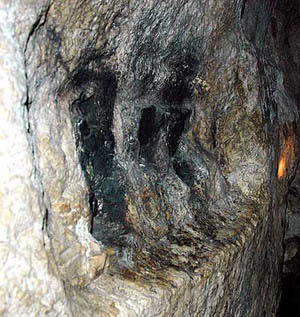
The
photo above shows where the inscription was cut from the side
of the tunnel near the exit.
|
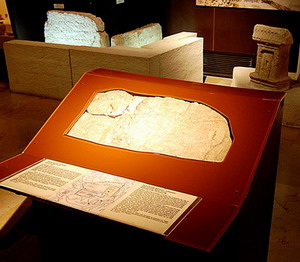
The Inscription. In the photo above we see the inscription
in its case in the Istanbul Archaeological Museum. I have
some closeup photos of the inscription but they are not sharp
enough to be useful. This is due to the condition of the inscription
and the fact that it is behind plastic.
|
The
photo this month [below] shows a false start made by the workers
who dug from the south. They made a correction and continued until
they met the workers coming from the Gihon spring.
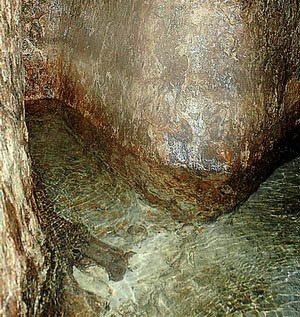 |
False
start. Looking toward Gihon Spring, we see where the workers
made a false start and then corrected to connect with the
workers coming toward Siloam.
|
At
the Siloam exit. This is the exit at the Byzantine pool
of Siloam. For a long time it was thought that this was
the pool from the time of Jesus (John 9). The recent discovery
of the pool from Roman times has helped to correct this.
|
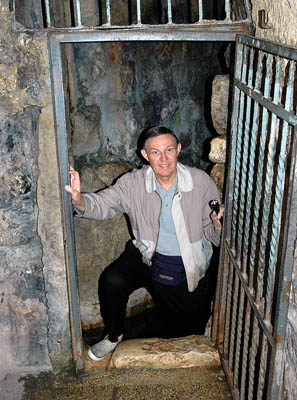 |
There
has been some talk recently (July, 2007) about Israel asking Turkey
to return the tunnel inscription. The countries seem to have a good
relationship, and this may happen. Israel does not allow photographs
to be made in the Israel Museum. In the Istanbul Archaeological
Museum, this is not a problem. Nor is it at the British Museum,
the Louvre, the New York Metropolitan, etc. Israel needs to move
up a notch on this practice. Every teacher prefers to use his/her
own photographs when possible.
Photos
© Ferrell Jenkins 2007.
The photos may be used by others in teaching, but may not be used
commercially or on web sites without permission. I do not sell photographs,
and at the present time I do not have time to honor requests for
high resolution copies of these photos. Thanks for your understanding.